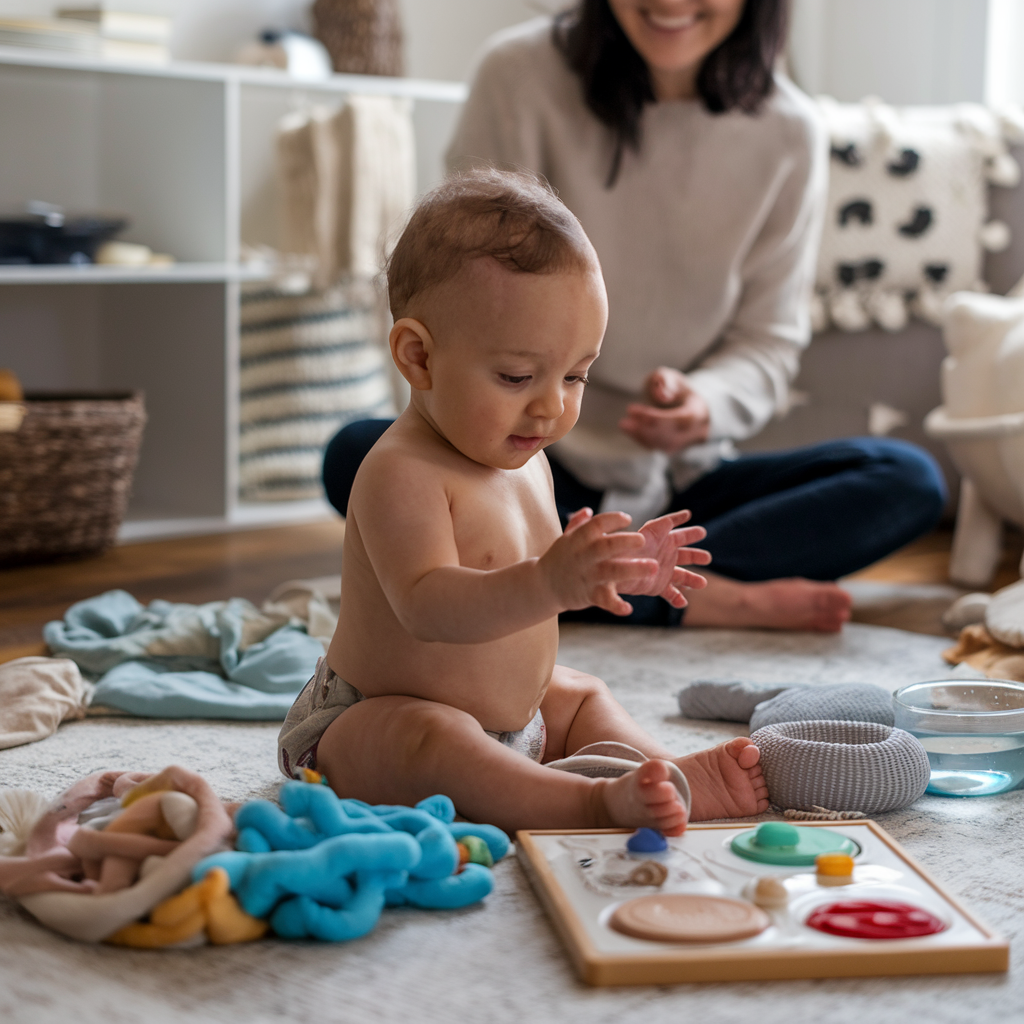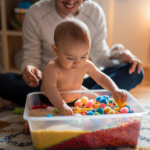As parents, we’re always looking for ways to encourage our babies’ growth, but did you know that sensory play can be one of the most effective methods? From touching different textures to hearing various sounds, sensory play for babies is more than just fun—it’s fundamental to their development. In this article, we’ll explore the numerous benefits of sensory play and provide some easy activities to get started.
Why Sensory Play is Important for Babies
Babies are little explorers who learn by touching, tasting, seeing, and hearing the world around them. Sensory play allows them to use all their senses to engage with their environment. This kind of activity not only promotes cognitive growth but also helps babies develop fine and gross motor skills, problem-solving abilities, and emotional resilience.
By providing opportunities for sensory exploration, parents can foster their child’s developmental milestones in a fun and interactive way.
Key Benefits of Sensory Play
- Cognitive Development: Sensory play stimulates the baby’s brain by encouraging it to form connections. When a baby feels the texture of a sponge or listens to the crinkling sound of paper, their brain is building pathways for cognitive growth.
- Motor Skill Development: From grasping soft toys to splashing water, babies are using their muscles in new ways. This helps in the development of both fine motor skills (small movements like picking up a button) and gross motor skills (larger movements like crawling or walking).
- Language Development: By engaging with different objects, babies start associating words with actions and textures. For example, saying « soft » while touching a blanket helps a baby learn the meaning of the word through direct experience.
- Emotional Growth: Babies can become frustrated or excited during sensory play, and that’s a good thing! Learning to manage these emotions helps in their emotional regulation as they grow older.
- Social Interaction: Group sensory activities encourage babies to observe and mimic their peers, boosting their social skills from a young age.
Types of Sensory Play Activities
Now that we understand the benefits of sensory play, let’s dive into some activities that are easy to do at home. The key is to provide babies with various sensory experiences, from tactile to auditory stimulation.
Tactile Sensory Play
Tactile activities focus on the sense of touch, helping babies explore textures, temperatures, and shapes.
- Sensory Bins: Fill a bin with different materials such as rice, pasta, or water beads. Let your baby dig in, touch, and explore.
- Textured Toys: Give your baby objects with different textures, such as soft blankets, sponges, or crinkly paper.
- Messy Play: For more adventurous babies, let them play with baby-safe paints or squish through some homemade playdough.
Visual and Auditory Sensory Play
Visual and auditory activities help develop a baby’s ability to process what they see and hear.
- Sound Bottles: Fill small bottles with objects like rice, beans, or buttons. Let your baby shake them and listen to the different sounds.
- Light Play: Use soft, colorful lights or reflective surfaces to capture your baby’s attention. Even a simple flashlight can provide endless entertainment.
- Musical Toys: Instruments like baby maracas or xylophones can introduce your baby to new sounds, and they’ll enjoy making their own « music. »
Taste and Smell Sensory Play
Although taste and smell activities should be done carefully, they’re also important aspects of sensory play.
- Food Exploration: Let your baby explore different baby-safe foods. From tasting mashed bananas to smelling cooked veggies, this type of play introduces them to new flavors and scents.
- Scented Playdough: Create baby-safe playdough and add a mild scent using vanilla or cinnamon to stimulate their sense of smell while they play.
How Sensory Play Helps in Early Development
The impact of sensory play goes beyond the immediate fun it provides. Research has shown that engaging babies in sensory activities can lead to faster development of neural pathways, helping them with future learning tasks. Babies who experience more sensory play often show quicker progress in areas like coordination, speech, and problem-solving.
Moreover, sensory play provides babies with a form of emotional expression. A baby exploring different textures or sounds is learning how to interact with their world, giving them a sense of independence and control over their environment. These small wins help build confidence, setting a strong foundation for later developmental stages.
How to Incorporate Sensory Play into Your Daily Routine
You don’t need fancy toys or complicated setups to incorporate sensory play into your baby’s routine. Everyday activities like bath time or feeding can easily become sensory-rich experiences.
- During Bath Time: Use sponges, bubbles, and cups for your baby to squeeze, pour, and touch different textures.
- Outdoor Walks: Let your baby feel the grass, listen to birds, and see the bright colors of flowers. Outdoor sensory play is a wonderful way to introduce new stimuli.
- Meal Times: Allow your baby to explore the texture of food before they eat. Finger foods can double as tactile play.
Conclusion: Why Sensory Play is Crucial for Your Baby’s Development
Incorporating sensory play for babies isn’t just about keeping them entertained—it’s an essential part of their development. From tactile experiences like feeling different textures to auditory stimulation through music, these activities build the foundation for cognitive, physical, and emotional growth.
So, next time your baby splashes water, giggles at a crinkling sound, or explores a new texture, remember that they’re not just having fun—they’re learning. Sensory play is a powerful tool in nurturing your baby’s early development, helping them grow into confident and capable toddlers.














